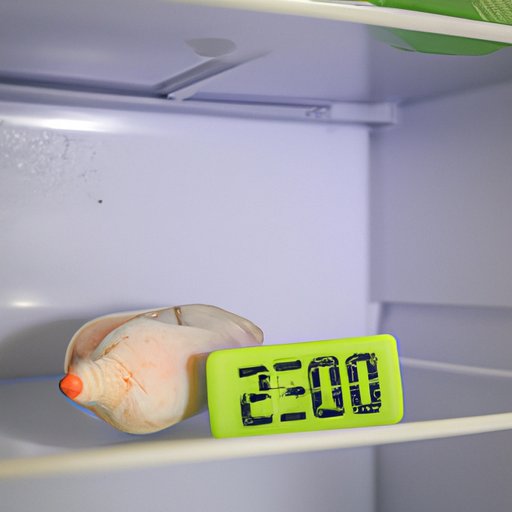Introduction
The temperature of your refrigerator has a big impact on the quality of the food you store in it. Keeping your fridge at the right temperature helps to ensure your food is stored safely and stays fresh for as long as possible. Let’s take a look at what the ideal temperature should be inside your refrigerator, why it’s important to maintain proper temperatures, and how to set and adjust the temperature accordingly.
How to Set the Right Temperature for Optimal Food Safety
The U.S. Department of Agriculture (USDA) recommends keeping the temperature inside your refrigerator between 34°F and 40°F (1°C to 4°C). Setting the temperature too low may result in food freezing, while setting the temperature too high increases the risk of food spoilage and contamination. To adjust the temperature, most refrigerators have a control panel located in the back or on the side. Some models may also have a dial which allows you to easily adjust the temperature up or down.
You may also need to adjust the temperature if your refrigerator has been recently serviced, or if you’ve recently added a lot of food. It’s important to give the refrigerator time to reach the desired temperature after making any adjustments. It should take about 24 hours for the temperature to stabilize.

Advantages and Disadvantages of Different Fridge Temperatures
The ideal temperature range for a refrigerator is between 34°F and 40°F (1°C and 4°C). However, there are advantages and disadvantages to setting the temperature either higher or lower than this range.
Setting your refrigerator temperature to colder than 34°F (1°C) will help keep food fresher for longer, but it can also lead to food freezing. This could damage the food, resulting in spoilage. On the other hand, setting the temperature too warm (above 40°F/4°C) increases the risk of bacteria growth, as well as food spoilage.

Impact of Temperature on Food Quality and Shelf Life
The temperature inside your refrigerator plays an important role in the quality and shelf life of the food you store. Foods will stay fresher and last longer when stored at the correct temperature. Colder temperatures slow down the growth of bacteria and other microorganisms, while warmer temperatures encourage bacterial growth, leading to food spoilage.
Foods that are particularly vulnerable to temperature changes include dairy products, meat, fish, fruits, and vegetables. In general, foods should not be stored in a refrigerator for more than two days. For some foods, such as meats, the recommended storage time is only one day.
Common Causes of Too High or Too Low Refrigerator Temperatures
Sometimes, despite your best efforts, the temperature inside your refrigerator may become too high or too low. This can happen for a variety of reasons, including:
- A malfunctioning thermostat
- An overstuffed refrigerator
- A damaged door seal
- A failing compressor
If you suspect that the temperature inside your refrigerator is too high or too low, you should check the temperature with an appliance thermometer.

Tips for Maintaining Proper Refrigerator Temperatures
To ensure your refrigerator maintains the optimal temperature, here are some tips:
- Keep the door closed as much as possible to prevent cold air from escaping.
- Organize your food so the air can circulate freely.
- Check the temperature regularly with an appliance thermometer.
- Schedule regular maintenance to check for any potential problems.
Conclusion
Setting and maintaining the right temperature in your refrigerator is essential for keeping your food safe and ensuring it has the best quality and shelf life. The ideal temperature range for a refrigerator is between 34°F and 40°F (1°C and 4°C). If the temperature deviates from this range, make sure to adjust it accordingly and monitor it regularly. With these tips, you can make sure your refrigerator stays at the right temperature and your food remains safe and fresh.


